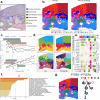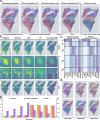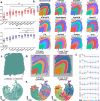STForte: tissue context-specific encoding and consistency-aware spatial imputation for spatially resolved transcriptomics
- PMID: 40254832
- PMCID: PMC12009714
- DOI: 10.1093/bib/bbaf174
STForte: tissue context-specific encoding and consistency-aware spatial imputation for spatially resolved transcriptomics
Abstract
Encoding spatially resolved transcriptomics (SRT) data serves to identify the biological semantics of RNA expression within the tissue while preserving spatial characteristics. Depending on the analytical scenario, one may focus on different contextual structures of tissues. For instance, anatomical regions reveal consistent patterns by focusing on spatial homogeneity, while elucidating complex tumor micro-environments requires more expression heterogeneity. However, current spatial encoding methods lack consideration of the tissue context. Meanwhile, most developed SRT technologies are still limited in providing exact patterns of intact tissues due to limitations such as low resolution or missed measurements. Here, we propose STForte, a novel pairwise graph autoencoder-based approach with cross-reconstruction and adversarial distribution matching, to model the spatial homogeneity and expression heterogeneity of SRT data. STForte extracts interpretable latent encodings, enabling downstream analysis by accurately portraying various tissue contexts. Moreover, STForte allows spatial imputation using only spatial consistency to restore the biological patterns of unobserved locations or low-quality cells, thereby providing fine-grained views to enhance the SRT analysis. Extensive evaluations of datasets under different scenarios and SRT platforms demonstrate that STForte is a scalable and versatile tool for providing enhanced insights into spatial data analysis.
Keywords: deep learning; graph autoencoder; imputation; self-supervised learning; spatial transcriptomics.
© The Author(s) 2025. Published by Oxford University Press.
Figures






Similar articles
-
Spatially Aware Domain Adaptation Enables Cell Type Deconvolution from Multi-Modal Spatially Resolved Transcriptomics.Small Methods. 2025 May;9(5):e2401163. doi: 10.1002/smtd.202401163. Epub 2024 Dec 2. Small Methods. 2025. PMID: 39623794
-
Spatially contrastive variational autoencoder for deciphering tissue heterogeneity from spatially resolved transcriptomics.Brief Bioinform. 2024 Jan 22;25(2):bbae016. doi: 10.1093/bib/bbae016. Brief Bioinform. 2024. PMID: 38324623 Free PMC article.
-
SpaMask: Dual masking graph autoencoder with contrastive learning for spatial transcriptomics.PLoS Comput Biol. 2025 Apr 3;21(4):e1012881. doi: 10.1371/journal.pcbi.1012881. eCollection 2025 Apr. PLoS Comput Biol. 2025. PMID: 40179332 Free PMC article.
-
Integrating Spatially-Resolved Transcriptomics Data Across Tissues and Individuals: Challenges and Opportunities.Small Methods. 2025 May;9(5):e2401194. doi: 10.1002/smtd.202401194. Epub 2025 Feb 11. Small Methods. 2025. PMID: 39935130 Free PMC article. Review.
-
Computational solutions for spatial transcriptomics.Comput Struct Biotechnol J. 2022 Sep 1;20:4870-4884. doi: 10.1016/j.csbj.2022.08.043. eCollection 2022. Comput Struct Biotechnol J. 2022. PMID: 36147664 Free PMC article. Review.
References
MeSH terms
Grants and funding
LinkOut - more resources
Full Text Sources

